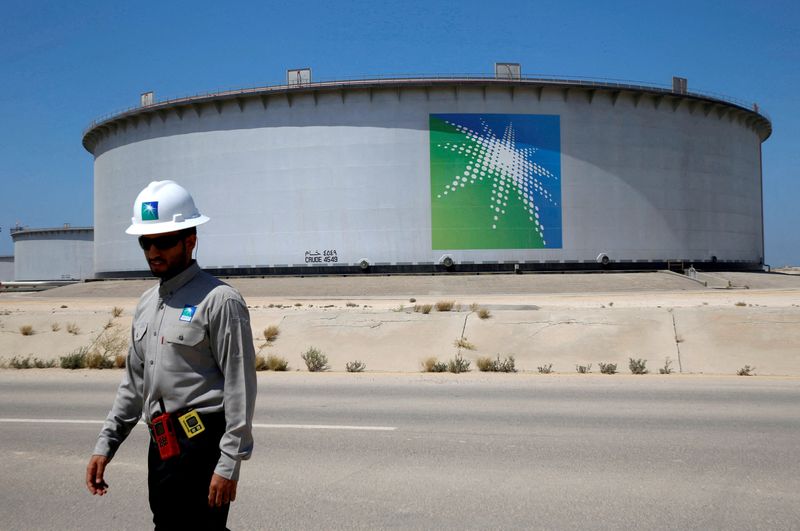Oil minimize extension raises danger of Saudi financial contraction this 12 months By Reuters

© Reuters. FILE PHOTO: FILE PHOTO: An Aramco worker walks close to an oil tank at Saudi Aramco’s Ras Tanura oil refinery and oil terminal in Saudi Arabia Could 21, 2018. REUTERS/Ahmed Jadallah/File Photograph/File Photograph
By Yousef Saba and Rachna Uppal
DUBAI (Reuters) -Saudi Arabia faces the danger of an financial contraction this 12 months following its choice to increase crude manufacturing cuts, highlighting its nonetheless heavy reliance on oil as reforms to diversify are sluggish transferring.
Riyadh says it goals to stabilise the oil market by extending a voluntary oil output minimize of 1 million barrels per day till the tip of 2023. Its announcement on Tuesday despatched oil costs above $90 for the primary time this 12 months, however they’re under common costs of round $100 a barrel final 12 months within the wake of Russia’s invasion of Ukraine.
Declining oil manufacturing and income this 12 months might see Saudi Arabia’s financial system shrink for the primary time since 2020 on the top of the COVID-19 pandemic, though a hefty dividend from state oil producer Saudi Aramco (TADAWUL:) ought to present a cushion for public funds.
Slicing oil output for an additional three months, on high of manufacturing cuts earlier within the 12 months, interprets right into a 9% fall in manufacturing in 2023 – the largest manufacturing drop in practically 15 years for OPEC’s de facto chief – mentioned analyst Justin Alexander at Khalij Economics.
Monica Malik, chief economist at Abu Dhabi Business Financial institution, now sees Saudi gross home product (GDP) contracting 0.5% this 12 months, revising her forecast from final month of 0.2% progress this 12 months, whereas Alexander mentioned non-oil progress would wish to common about 5% this 12 months to keep up progress.
“This was truly exactly the expansion price in H1, however main indicators such because the PMI (buying managers’ index) have pointed to a modest slowdown, in order that may be arduous to maintain in H2. Consequently a small actual GDP contraction is trying seemingly,” Alexander, additionally Gulf analyst at GlobalSource Companions, mentioned.
Final 12 months the Saudi financial system grew 8.7% and generated a fiscal surplus of two.5% of GDP, its first surplus in 9 years as oil soared to highs close to $124. This 12 months the federal government has forecast a surplus of 0.4% of GDP, however some economists say even which may be optimistic.
Saudi Aramco, 90% authorities owned and awash with money after final 12 months’s increase, mentioned final month it might fork out a close to $10 billion dividend to shareholders within the third quarter from its free money circulation – the primary of a number of additional payouts on high of its anticipated greater than $150 billion base dividend for 2022 and 2023 mixed.
“Even so, we expect that the federal government will run a funds deficit of 1.5% of GDP this 12 months – effectively under the Finances estimate for a 0.4% of GDP surplus,” James Swanston of Capital Economics mentioned in a observe.
The Saudi finance ministry didn’t instantly reply to a request for remark.
The dominion’s deficit stood at 8.2 billion riyals ($2.19 billion) for the primary half of this 12 months.
An official from the Worldwide Financial Fund, which had forecast a 1.2% of GDP deficit this 12 months, mentioned on Thursday the funds could be nearer to stability because of the additional Aramco payout and, in contrast to a rising variety of economists, the IMF additionally believes the financial system will handle slight progress this 12 months.
PIF KEEPS SPENDING
Progress within the non-oil financial system stays sturdy for now.
The Public Funding Fund (PIF), the sovereign wealth fund tasked with driving Saudi Arabia’s formidable Imaginative and prescient 2030 financial blueprint, has spent billions on high world soccer stars, golf, tourism and leisure, and electrical car makers.
“Definitely, we see no indicators that the Public Funding Fund’s acquisition streak is cooling,” RBC Capital Markets mentioned in a observe.
PIF didn’t instantly reply to a request for remark.
Nonetheless, reforms and state-led funding have seen the share of the non-oil sector’s contribution to GDP rise to 44% of GDP final 12 months, up simply 0.7 share level from 2016.
“I believe the truth has sunk in that the tempo of change can not transfer as rapidly as had been hoped and the financial system stays dependent upon hydrocarbons and can achieve this for a while,” mentioned Neil Quilliam, affiliate fellow at Chatham Home in London.
As much as $50 billion price of recent Aramco shares might be provided on the Riyadh bourse earlier than the tip of the 12 months, in line with experiences, producing huge funds that might be spent on large tasks. The federal government has transferred 8% of Aramco to PIF and one in every of its subsidiaries.
PIF’s funding comes from capital injections and asset transfers from the federal government, debt and earnings from investments. Nevertheless, it reported a lack of $15.6 billion final 12 months, primarily attributable to its SoftBank (TYO:) Imaginative and prescient Fund I funding and a wider market downturn, particularly in tech.
“To this point PIF investments have not confirmed to be as fruitful as had been hoped and neither has the nation attracted the FDI (international direct funding) it had hoped both… So Aramco goes to be the horse that they carry on beating,” Quilliam mentioned.
($1 = 3.7507 riyals)
